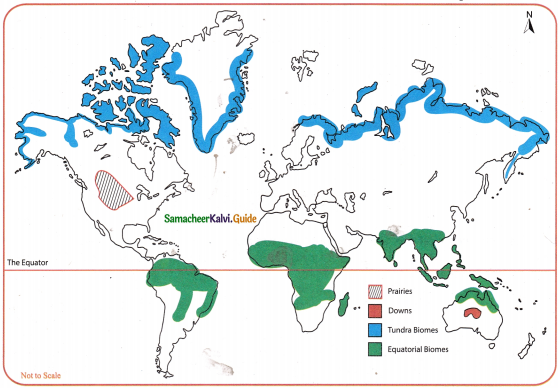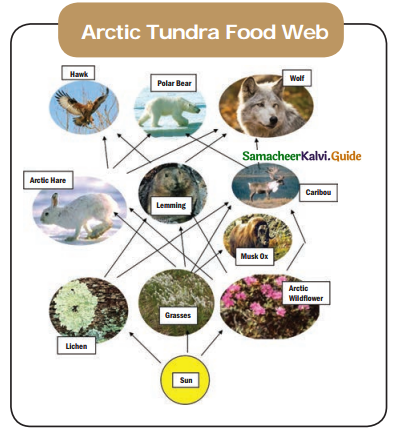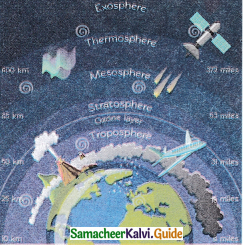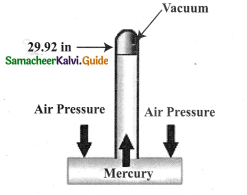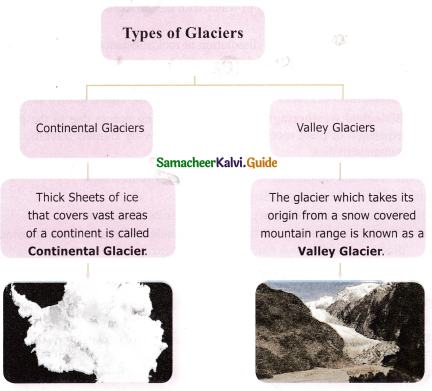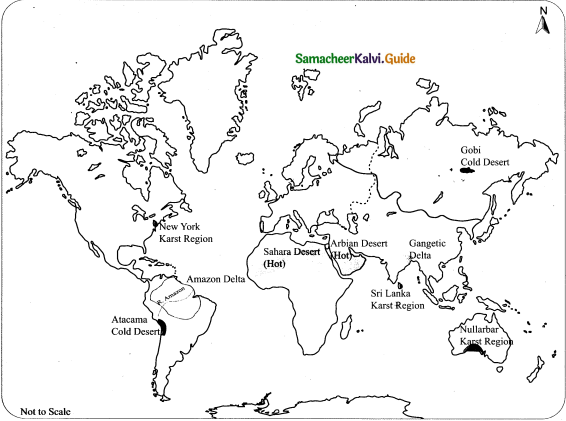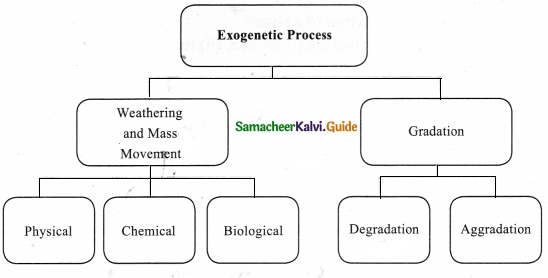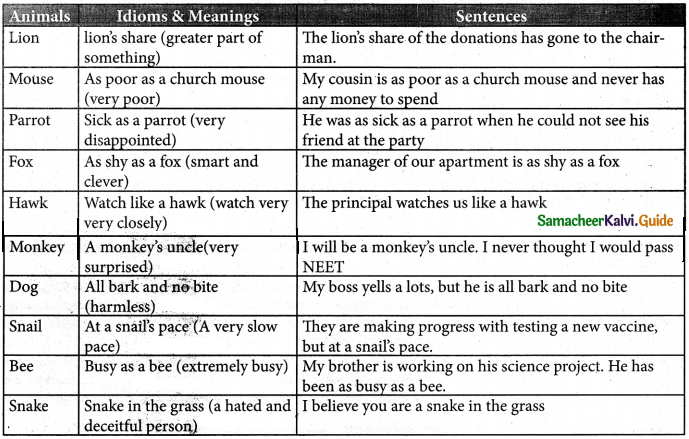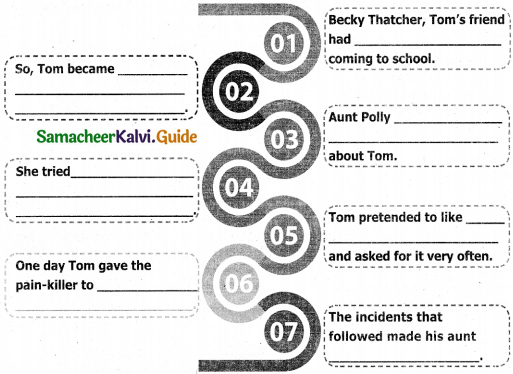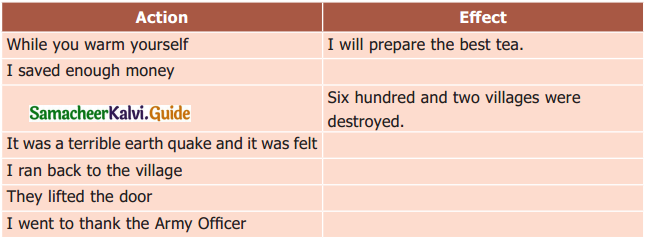Tamilnadu State Board New Syllabus Samacheer Kalvi 9th Social Science Guide Pdf Geography Chapter 6 Man and Environment Text Book Back Questions and Answers, Important Questions, Notes.
Tamilnadu Samacheer Kalvi 9th Social Science Solutions Geography Chapter 6 Man and Environment
Samacheer Kalvi 9th Social Science Man and Environment Text Book Back Questions and Answers
I. Choose the correct answer
Question 1.
All externa Influences and factors that affect the growth and development of living organisms is __________
(a) Environment
(b) Ecosystem
(c) Biotic factors
(d) Abiotic factors
Answer:
(a) Environment
![]()
Question 2.
The ‘World Population Day’ is observed on __________ every year.
(a) August 11th
(b) September 11th
(c) July 11th
(d) January 11th
Answer:
(c) July 11th
Question 3.
The statistical study of human population is __________
(a) Demography
(b) Morphology
(c) Etymology
(d) Seismography
Answer:
(a) Demography
Question 4.
The extraction of valuable minerals and other geological minerals from the mines, is __________
(a) Fishing
(b) Lumbering
(c) Mining
(d) Agriculture
Answer:
(c) Mining
![]()
Question 5.
The Secondary sector of the economy produces __________ from raw materials.
(a) Semi finished goods
(b) Finished goods
(c) Economic goods
(d) raw materials
Answer:
(b) Finished goods
Question 6.
Gradual increase of the earth’s temperature by the Green house gases in the atmosphere is called __________
(a) Acid rain
(b) thermal pollution
(c) Global warming
(d) Deforestation
Answer:
(c) Global warming
II. Mitch the following
- Loudspeaker – (a) Push factor
- Rio de Janeiro, Brazil – (b) Pull factor
- Cruciform settlement – (c) noice pollution
- Natural disaster – (d) T- shaped settlement
- Better living conditions – (e) Earth Summit, 1992
Answer:
- – (c)
- – (e)
- – (d)
- – (a)
- – (b)
III. Consider the given statements and choose the right option given below
Question 1.
Assertion(A): Ozone layer in the stratosphere is considered as a protective shield.
Reason(R): It prevents the UV radiation from reaching the earth’s surface.
(a) A and R are correct and A explains R
(b) A and R are correct, but A does not explain R
(c) A is incorrect but R is correct
(d) Both A and R are incorrect
Answer:
(a) A and R are correct and A explains R
![]()
Question 2.
Assertion(A): In tertiary activities, instead of producing goods by themselves, they are in the process of production.
Reason(R): People in Tertiary activities are purely eco friendly.
(a) Both A and R are incorrect
(b) A and R are correct but A does not explain R
(c) A is correct and R is incorrect
(d) A and R are correct and A explains R
Answer:
(c) A is correct and R is incorrect
IV. Answer the following in brief
Question 1.
What do you mean by the term ‘density’ of population’?
Answer:
Density of population refers to the number of people living per square kilometre. An area is said to be sparsely populated when it has a large area with less number of people. Similarly, smaller the area with a large number of people, it is said to be densely populated.
Question 2.
What is ‘black death’?
Answer:
- The Black death is estimated to have killed 30 – 60 percent of Europe’s total population during the 14th century.
- The dominant explanation for black death is attributed to the outbreak of plague.
![]()
Question 3.
Where do we have high and low densities of population?
Answer:
Areas of high density (above 50 people per sq.km) – East Asia, South Asia, northwest Europe & Eastern North America.
Areas of low density (less than 10 people per sq.km) – Central Africa, Western Australia, Northern Russia, Canada, etc.
Question 4.
Write any two ways of how the locals and the government restored Palk Bay.
Answer:
- Saplings of native species of plants and trees are being grown planet and cared for
- Live colonies of coral from the Gulf of Mannar Biosphere Reserve are being transplanted to Palk Bay. The existing mangroves and the region are being mapped and the way land is used around the mangrove is being studied.
- Along with awareness programmes, the communities are also being provided with livelihood training, so they can earn an income in more ways than just fishing.
Question 5.
Define.
- Population growth
- Infant Mortality Rate
- Census
- Sustainable Development.
Answer:
- Population growth refers to an increase in the number of people who reside in a particular area during a particular period.
- The number of deaths under one year of age for every 1000 live births in a year is known as Infant Mortality Rate
- Census is an official enumeration of population carried out periodically. It records information about the characteristics of population such as age, sex, literacy and occupation.
- “Sustainable development is development that meets the needs of the present without compromising the ability of future generation to meet their own needs”.
V. Give reasons for the following.
Question 1.
Deforestation is encouraged throughout the world.
Answer:
Deforestation results in many effects like floods and droughts, loss of soil fertility, air pollution, extinction of species, global warming, spread of deserts, depletion of water resource, melting of ice caps and glaciers, rise in sea level and depletion of ozone layer. Therefore, reforestation is encouraged throughout the world in order to conserve our mother Earth.
Question 2.
Acid rain destroys the ecosystem.
Answer:
- Acid rain has many ecological effect, but none is greater than its impact on lakes, streams, wetlands and other aquatic environments.
- Acid-rain makes water acidic, and causes them to absorb the aluminium that makes its way from soil into lakes and streams.
- It limits the nutrients available to the plants and expose them to toxic substances that are released from soil.
![]()
Question 3.
The economy of the quaternary sector is called the knowledge economy.
Answer:
The quaternary sector deals with the activities related to Research and Development, as well as knowledge. For e g. Services like consultation, education, and banking. Hence, it is called a knowledge economy.
Question 4.
Population growth has to be brought under control.
Answer:
- Urgent steps need to be taken to stabilise the population for sustainable development goals to be achieved.
- Through education awareness of the problems faced due to population explosion like pollution, scarcity of resources, conflict low standard of living and disruption in the ecological balance.
Question 5.
Sustainable development growth has been set to protect the planet.
Answer:
The excessive usage of natural and manmade resources deplete its availability for the future generation. Hence conservation and awareness are the two important terms that can bring sustainability to our living: When we use the word sustainability to mean maintain, it means to maintain it forever. This is because our actions have a lasting effect on the environment and we should protect it for our future generations.
VI. Distinguish the following
Question 1.
Birth Rate and Death Rate.
Answer:
Birth rate:
The number of live birth per 1000 children in a country during a year.
Death Rate:
The number of death per 1000 people in a country during a year.
Question 2.
Rural settlement and urban settlement
Answer:
Rural settlement:
- An area located in the outskirts, is known as rural.
- Villages and hamlets constitute ‘rural areas.
Urban settlement:
- A settlement where the population is very high and has the features of a built environment, is known as urban.
- Cities and towns constitute urban areas.
![]()
Question 3.
Primary activities and Secondary activities
Answer:
Primary Activities:
- Primary activities pertain to the extraction of raw materials from the earth’s surface.
- For example: Food gathering, hunting, lumbering, fishing, cattle rearing, mining and agriculture.
Secondary Activities:
- Secondary activities transform raw materials into finished goods.
- For example: Iron and steel industries, automobile manufacturing etc.,
VII. Answer in a paragraph
Question 1.
Explain the factors affecting the distribution of the population.
Answer:
The world population is not uniformly distributed, owing to the following factors.
- Physical Factors: Physical factors include temperature, rainfall, soil, relief, water, natural vegetation, distribution of minerals and availability of energy resources.
- Historical Factors: Regions with historical importance (river valley civilizations), war and constant invasions fall under historical factors responsible for population distribution.
- Economic Factors: Educational institutions, employment opportunities, manufacturing industries, luxurious amenities, trade and commerce and other facilities encourage dense population in an area.
Question 2.
Describe the patterns of rural settlement with neat diagrams.
Answer:

VIII. Map Skill
Question A.
On the outline map of the world mark the following.
- An area of high density of population in Europe.
- An area of low density of population in Australia.
- PalkBay.
- A fracking banned country.
- England – A country affected by ‘black death’
- Denmark – First country where the modem census was conducted.
- River Hwang Ho.
Answer:
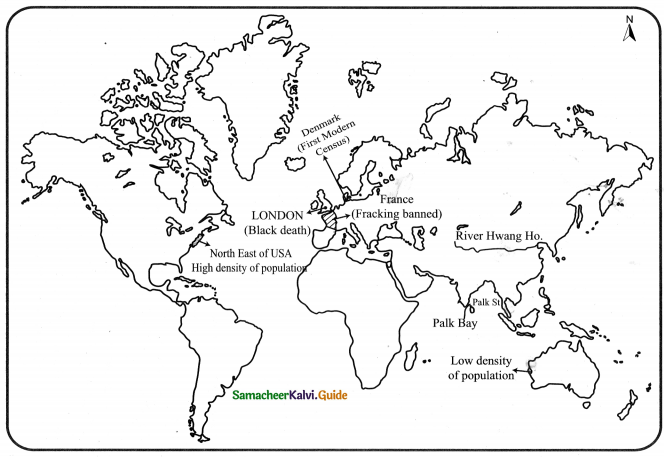
Question B.
On the outline map of Tamil Nadu mark the following.
- A metropolitan city
- A district with 7857 people per sq. km.
- Gulf of Mannar
- Palk Strait
Answer:
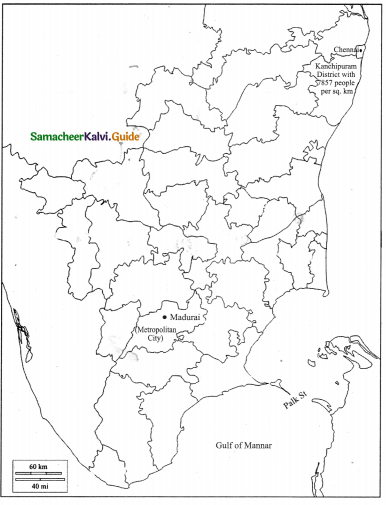
IX. Hots
Question 1.
Study your area and write down its settlement pattern.
Answer:
- A settlement pattern refers to the way that buildings and houses are distributed in a rural settlement.
- Settlement patterns are of interest to geographers, historians and anthropologists for the insight they offer in how a community has developed over time.
Linear:
In a linear settlement pattern, the buildings are arranged in lines. These lines often follow the route of a road or body of water.
Dispersed:
In a dispersed settlement pattern, the buildings are scattered over a wide area. Dispersed settlement patterns are often associated with agricultural activity and are frequently surrounded by farmland.
Nucleated:
In a nucleated settlement pattern, the buildings are grouped around a central core. Nucleated settlement patterns are usually associated with patterns of agriculture in which the settlement is surrounded two or three fields, and each field divided into strips that were formed b individual farmers.
Samacheer Kalvi 9th Social Science Man and Environment Additional Important Questions and Answers
I. Choose the correct answer
Question 1.
The percentage of people in a given population who can read and write a language refer to ______
(a) Infant mortality
(b) Literacy rate
(c) Sex ratio
(d) Populationdensity
Answer:
(b) Literacyrate
![]()
Question 2.
In India the first census was carried out in the year ________
(a) 1800
(b) 1821
(c) 1872
(d) 1880
Answer:
(c) 1872
Question 3.
At the Confluence of river this pattern is developed ________
(a) Starlike
(b) Triangular
(c) Nebular
(d) Circular
Answer:
(b) Triangular
Question 4.
Automobile manufacturing comes under this economic activity
(a) Primary
(b) Tertiary
(c) Secondary
(d) Quaternary
Answer:
(c) Secondary
Question 5.
Van Mahotsav week celebrated during
(a) 1st July to 7th July
(b) 1st June to 7th June
(c) 1st January to 7th January
(d) 1st December to 7th December
Answer:
(a) 1st July to 7th July
Question 6.
News paper and Cardboard belong to
a) Wet waste
(b) Dry waste
(c) Rejected waste
(d) e – waste
Answer:
(b) Dry waste
![]()
Question 7.
Palk Bay is the home of
(a) Coconut trees
(b) Dry waste
(c) Mangrove trees
(d) e – waste
Answer:
(c) Mangrove trees
Consider the given statement and choose the right option given below.
Question 8.
Assertion(A): Deforestation results in floods and drought.
Reason(R): Under deforestation trees are cut down clearing the forests.
(a) Both A and R are correct
(b) Bpth A and R are wrong
(c) A is correct but R does not explain A
(d) A and R are correct and A explains R
Answer:
(d) A and R are correct and A explains R
Question 9.
Assertion(A): Urbanisation is one of the environmental issues.
Reason(R) : As the town expands, it mounts more pressure on transport system, water supplies leading to air pollution, water pollution etc.
(a) (A) and (R) are correct, (R) explain (A)
(b) (A) and (R) are correct, (R) does not explain (A)
(c) Both (A) and (R) are correct
(d) Both (A) and (R) are wrong
Answer:
(a) (A) and (R) are correct, (R) explain (A)
II. Match the following
- Monuments – (i) Low density
- Denmark – (ii) Rectangular Pattern
- Northern Russia – (iii) Madurai
- Plain Areas – (iv) Man – Made
- Metropolitan – (v) Census
Answer:
- – (iv)
- – (v)
- – (i)
- – (ii)
- – (iii)
III. Answer the following in brief
Question 1.
Classify the Environment.
Answer:
Environment can be classified as
- Natural Environment
- Human Environment and
- Man Made Environment
Question 2.
What is demography?
Answer:
- In ancient Greek, ‘demos’ means people and ‘graphis’ means study of measurement.
- So ‘Demography’ is the statistical study of human population.
![]()
Question 3.
What is National Increase of population?
Answer:
National increase of population is the difference between the birth rate and death rate.
Question 4.
What is population change?
Answer:
Population change refers to an increase or decrease in the population of an area influenced by the number of births, deaths and migration.
Question 5.
Why do we observe the The World Population Day?
Answer:
- The World Population Day is observed on 11th July every year.
- It seeks to raise awareness of global population issues.
- The United Nations Development Programme started celebrating this event from the year 1989.
Question 6.
Mention about the official population policy implemented in 1952.
Answer:
- India has an official population policy implemented in 1952.
- India was the first country to announce such a policy.
- The main objective of this policy was to slow down the rate of population growth, through . promotion of various birth control measures.
Question 7.
Explain the Quinary Activities.
Answer:
- The activities that focus on the creation, rearrangement, and interpretation of new and existing ideas are called quinary activities.
- It includes the highest levels of decision making in a society or economy.
- Eg. Senior business executives, scientists and policymakers in the Government.
Question 8.
Explain the term afforestation.
Answer:
- Afforestation is the process of planting trees or sowing seeds on barren land devoid of any trees to create a forest.
- Therefore afforestation is the creation of a new forest.
Question 9.
What is forest management?
Answer:
- Forest Management seeks to achieve a balance between the society’s increasing demands for forest products, its benefits and the preservation of forest health and diversity too.
- This balance is critical to the survival of forests and to the prosperity of forest dependent communities.
![]()
Question 10.
What are natural pollutants?
Answer:
The natural pollutants are volcanic eruptions, wind erosion, pollen disposal, evaporation of organic compounds and radioactive elements etc.,
Question 11.
What are man made pollutants?
Answer:
Man made pollutants refer to vehicular emission, industrial wastes, smoke from thermal power plants and refineries badly affects the environment.
Question 12.
Mention any three ways to conserve Water.
Answer:
- To conserve water do not dump in or around rivers. Clean up rivers that have a lot of trash in and around them.
- Never dispose of cooking fats and oils by proving them down the sink.
- Turn off water while brushing teeth, washing, gardening and sharing.
Question 13.
Mention the preventive measures of land pollution.
Answer:
- Things used for domestic purposes can be reused and recycled.
- Organic waste matter should be disposed off far away from the settlements.
- Inorganic wastes can be separated, reclaimed and recycled.
Question 14.
What is Smog?
Answer:
- Smog is a mixture of smoke, gases and chemicals.
- It causes a smoky dark atmosphere, especially over cities.
- It decreases visibility and creates haze throughout the area.
Question 15.
Mention the problems of Urbanisation.
Answer:
- As the town expands, it mounts more pressure on transport system, water supplies, sewage and profuse disposal.
- The overall development creates problems like air pollution, water pollution, traffic congestion and noise pollution etc.
- This disturbed environment affects the human beings as mental illness, heart troubles, breathing problems etc.
Question 16.
Why is Sustainability important?
Answer:
- The excessive usage of natural and manmade resources deplete its availability for the future generation.
- We need to look after our planet, our resources and our people to ensure that we can hand over our planet to our children to live in true sustainability.
- Hence conservation and awareness are the two important terms that can bring sustainability to our living.
- When we use the word sustainability to mean maintain, it means to maintain it forever.
- This is because our actions have a lasting effect on the environment and we should protect it for our future generations.
IV. Distinguish the following
Question 1.
Internal Migration and International Migration.
Answer:
Internal Migration:
- The movement of people within a country i.e. between states, districts, villages, etc is called as Internal migration.
International Migration:
- The movement of people from one country to another, across international borders is called as International migration.
![]()
Question 2.
Land Pollution and Noise Pollution.
Answer:
Land Pollution:
- Land pollution is contaminating the land surface of the earth through dumping of urban waste matter.
- It arises from the breakage of underground storage tanks, application of pesticides and percolation of contaminated surface water, oil and fuel dumping.
- One of the preventive measures. Inorganic wastes can be separated, reclaimed and recycled.
Noise Pollution:
- Noise pollution is basically a problem of urban areas, industrial areas, transport areas due to bombardment, traffic etc.
- It has an impact on the habitat of animals migration and health of inhabitants.
- One of the control measures planting trees along the compound walls to protect houses.
Question 3.
Push factors and pull factors
Answer:
Push Factors:
- In sufficient jobs and few opportunities.
- Primitive conditions
- Pollution
- Poor infrastructural facilities
Pull factors:
- Better job opportunities.
- Better living conditions
- Clean environment
- Better infrastructural facilities
V. Give reasons for the following
Question 1.
Fracking’affect the environment.
Answer:
- Fracking not only pollutes water and air but also pollutes the soil.
- The oil spills during fracking can harm the soil and the surrounding vegetation.
- The use of high pressure at the time of soil extraction and the storage of waste water on site may cause earthquakes.
Question 2.
Segregate bio degrable
Answer:
- We should segregate biodegradable and non-biodegradable wastes so that we can easily notice and separate all biodegradable which can be used as a fertilizer. While nonbiodegradable can be recycled.
- Segregate of wastes in important for properly disposing of the huge amount of garbage in an environmentally conscious manner.
VI. Answer in a paragraph.
Question 1.
Explain the classification of the Environment.
Answer:
(a) Natural Environment
(b) Human Environment
(c) Man made Environment
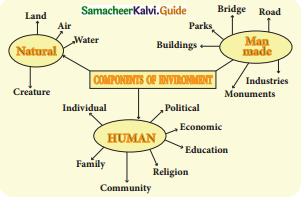
(a) Natural Environment : Natural components of environment such as Lithosphere, atmosphere, hydrosphere and biosphere.
(b) Human Environment : This is the interaction between man as an individual, with his family, occupation and society. It is also related to various cultural aspects such as education, religion, economics and politics.
(c) Man made Environment :
- This has been created by man himself for the purpose of fulfilling his needs and to make his life more convenient and easy.
- For example, building, transport, park, industries, monument, etc.
- To bring an equilibrium between man and the environment, man has to study the distribution of population, availability of resources, development in technology etc.
![]()
Question 2.
Explain the term density of population.
Answer:
- Density of population refers to the number of people living per sq. km. An area is said to be sparsely populated when it has a large area with less number of people. Similarly, smaller the area with a large number of people, it is said to be densely populated.
- Population Density = \(\frac { Total Population }{ Total land area }\)
The world’s population density is divided into three main groups.
(a) Areas of high density (above 50 people per sq.km) – East Asia, South Asia, North West Europe & Eastern North America.
(b) Areas of moderate density (10 to 50 people per sq.km) – The sub tropical regions like Angola, Congo, Nigeria and Zambia in Africa.
(c) Areas of low density (less than 10 people per sq.km) – Central Africa, Western Australia, Northern Russia, Canada, etc…
Question 3.
What is ‘Migration’? and explain its types.
Answer:
- Migration is defined as the permanent or semi-permanent change of home of an individual or a group of people over a significant distance from their place of birth.
- The causes of migration may be physical (climate, drought, flood, earthquake, volcanic eruption, epidemics etc.), social inequalities, economic opportunities, technology, education, cultural clashes, war or political issues.
- There are two types of migration:
(a) Internal Migration – The movement of people.within a country i.e. between states, districts, villages, etc is called as Internal migration.
(b) International Migration – The movement of people from one country to another, across international borders is called as International migration.
Question 4.
What are Urban Settlements? apd explain its types.
Answer:
- Urban is the term related to cities and towns where people are primarily engaged in non-agricultural activities.
- The factors responsible for urbanization are better employment opportunities, suitable conditions for business, education, transport, etc.
- Urban centres are classified as towns, cities, metropolitan cities, mega cities, conurbation, etc., depending on the size and services available and functions rendered to it.
(a) Town : A town is generally larger than a village, but smaller than a city. It has a population of less than 1 lakh. E.g.: Arakkonam.
(b) City : Cities are much larger than towns and have a greater number of economic
functions. The population in cities are estimated to be more than 1 lakh. E.g.: Coimbatore
(c) Metropolitan Cities : Cities accommodating population between 10 lakhs and 50 lakhs are metropolitan cities. E.g.: Madurai
(d) Mega cities : Cities with more than 50 lakh population are called Megacities. E.g.: Chennai
(e) Conurbation : A conurbation is a region comprising of a number of cities, large towns and other urban areas. E.g.: Delhi
Question 5.
What are the effects of Deforestation?
Answer:
- Deforestation results in many effects like floods and droughts, loss of soil fertility, air pollution, extinction of species, global warming, spread of deserts, depletion of water resource, melting of ice caps and glaciers, rise in sea level and depletion of ozone layer
- The United Nations Conference on Environment and Development (UNCED) by name Earth Summit Conference held at Rio de Janeiro, Brazil, on June 1992 concluded that all member countries should reduce their emission of carbon dioxide, methane and other green house gases thought to be responsible for global warming.
Question 6.
How can we conserve forests?
Answer:
- Conservation of forests can be done through the regulation of cutting of trees.
- Control over forest fire: Through regular monitoring and controlling the movement of the people forest fire can be prevented.
- Reforestation and afforestation: Reforestation involves the replanting or regeneration of areas of forest which have previously been damaged or destroyed.
Sometimes forests are able to regenerate naturally. Afforestation is the process of planting trees or sowing seeds on barren land devoid of any trees to create a forest. - Proper use of forest products: We depend on forests for our survival from the air we breathe, to the wood we use.
Besides providing habitats for animals and livelihoods for humans, forest products are one of the most essential things in our day to day life. Therefore we must use forest products properly. - Sustainable forest management: The use of forest and forest lands in a way and at a rate, that maintains their biodiversity, productivity, regeneration capacity, vitality and their potential to fulfill the global levels should not cause damage to other eco systems.
![]()
Question 7.
Write short note on
(a) Green House Effect
(b) Add Rain
Answer:
(a) Green house :
- Global warming is caused by the increase of green house gases such as carbondioxide, methane, water vapour and Chloro Fluoro Carbons(CFC), carbon monoxide, photo chemical oxidants and hydrocarbons.
- They are responsible for the heat retention ability of the atmosphere.
- Global warming causes climatic change, ozone layer depletion, rise in sea level and drowning of coastal inhabited land, melting of ice, etc.,
- They are posing an even greater threat to human existence and so, man must start thinking of protecting the environment from pollution.
(b) Acid Rain :
- When pollutants combine with water vapour in the presence of sunlight and oxygen, they form dilute sulphuric and nitric acids in the atmosphere.
- When this mixture precipitates from the atmosphere, 0 is called acid rain.
- The gases that cause acid rain are sulphur-di-oxide, nitrogen oxides, carbon-di-oxide and other minute bio-products, caused by the burning of fossil fuels.
Question 8.
W rite a note on Ozone layer.
Answer:
- Ozone is a poisonous gas made up of molecules consisting of three oxygen atoms (03).
This gas is extremely rare in the atmosphere, representing just three out of every 10 million molecules. - The ozone layer is not really a layer at all, but has become known as such because most ozone particles are scattered between 19 and 30 kilometre up in the earth’s atmosphere, in a region called the stratosphere.
- Ozone layer in the atmosphere absorbs most of the harmful ultraviolet radiation from the sun.
- It also screens out the deadly UV-C radiation the ozone shield is this essential to protect life.
Question 9.
Explain the term Fracking.
Answer:
- The modem technology applied to extract oil and gas while fracturing the rocks artificially with the use of pressurized liquid is called fracking.
- Fracking fluid is a mixture of water, sand and thickening agents.
- The first successful implementation of the process was done in 1950.
- Methane is one of the most important chemicals used in fracking process.
- It is estimated that four percent of methane escapes into the atmosphere during extraction.
- Methane is 25 times stronger than carbon di-oxide in terms of trapping heat.
- The spills of this gas is detrimental to the air quality of the surrounding fracking sites
- Pollutants decrease the availability of clean air for workers and local residents.
![]()
Question 10.
How to dispose a Waste?
Answers:
- Do not litter your surroundings. Use a proper waste bin to store your wastes.
- People should practise to segregate degradable and non-degradable wastes and should dispose
them in proper coloured bins. Wastage is generally classified into three types. They are
(a) Wet Waste: It comes from the kitchen/cooking/food, etc.
(b) Dry Recyclable Waste : Such as newspapers, cardboard, packing plastics, bottles, cans, etc., should go to a different bin.
(c) Rejected Waste: which does not belong to the above two categories, including bio waste like diapers and bandages, etc.
(d) Sewage: sewage slude is produced by waste water treatment processes. Due to rapid urbanization, there has been an increase in municipal waste water.
Electronic Waste (e-waste):
- It can be defined as any electrical goods, devices or components that you no longer want or have already thrown away. For example, computers, televisions, mobiles and fax machines.
- This waste can take many years to break down.
- It can contain toxic chemicals such as mercury, lead and lithium that leach into the ground and cause illness.
- Instead of sending e-waste to the dump, components from electronics can be reused to make new products.
Question 11.
Explain the term sustainable development. Why should we balance the economic, social and environmental factors of sustainability in equal harmony?
Answer:
- “Sustainable development is development that meets the needs of the present without compromising the ability of future generation to meet their own needs”.
- For sustainable development tp be achieved, it is crucial to harmonize three core elements: economic growth, social aspects and environmental protection.
- These elements are interconnected and are crucial for the well-being of individuals and societies.
- To achieve true sustainability, we need to balance the economic ,social and environmental factors of sustainability in equal harmony.
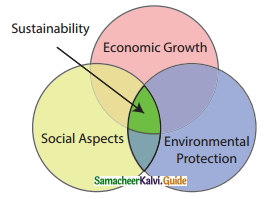
Social Sustainability :
- The ability of a social system such as a country, family or organization to function at a defined level of social well being and harmony is called social sustainability.
- The balancing capacity of a government in maintaining peaceful existence towards other countries and at the same time providing the requirements of its citizens without affecting the environment creates social sustainability.
Economic Sustainability :
- The economic sustainability is successfully implemented through strong Public Distrubution System.
- Economic sustainability ensures that our economic growth maintains a healthy balance with our ecosystem.
Environmental Sustainability :
- It is the ability of the environment to support a defined level of environmental quality and natural resource extraction rates forever to mankind.
- Unnecessary disturbances to the environment should be avoided whenever possible.
